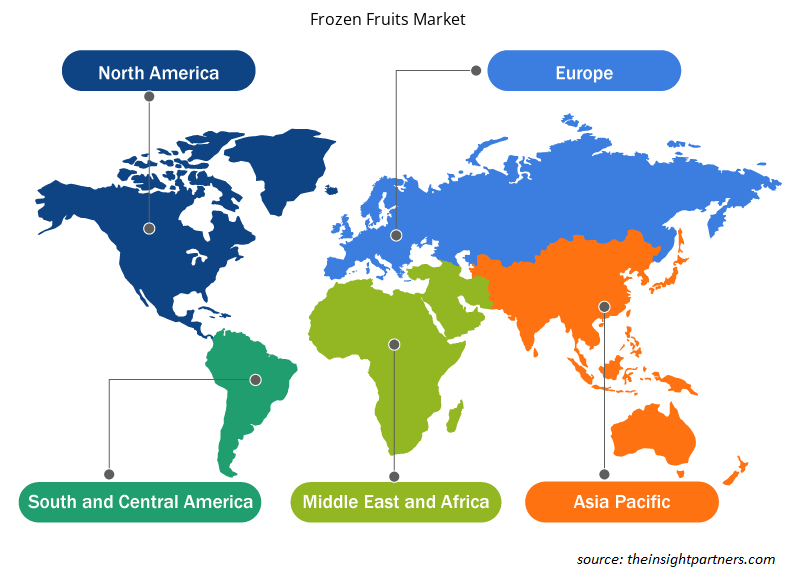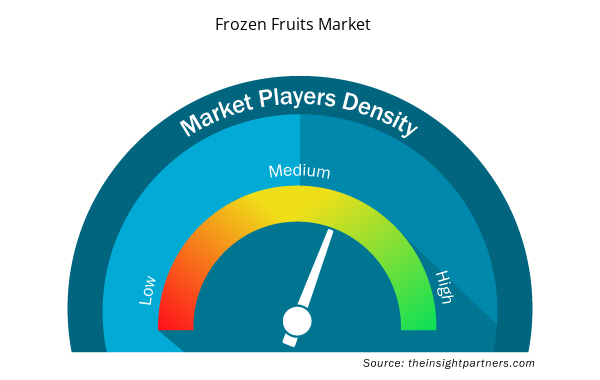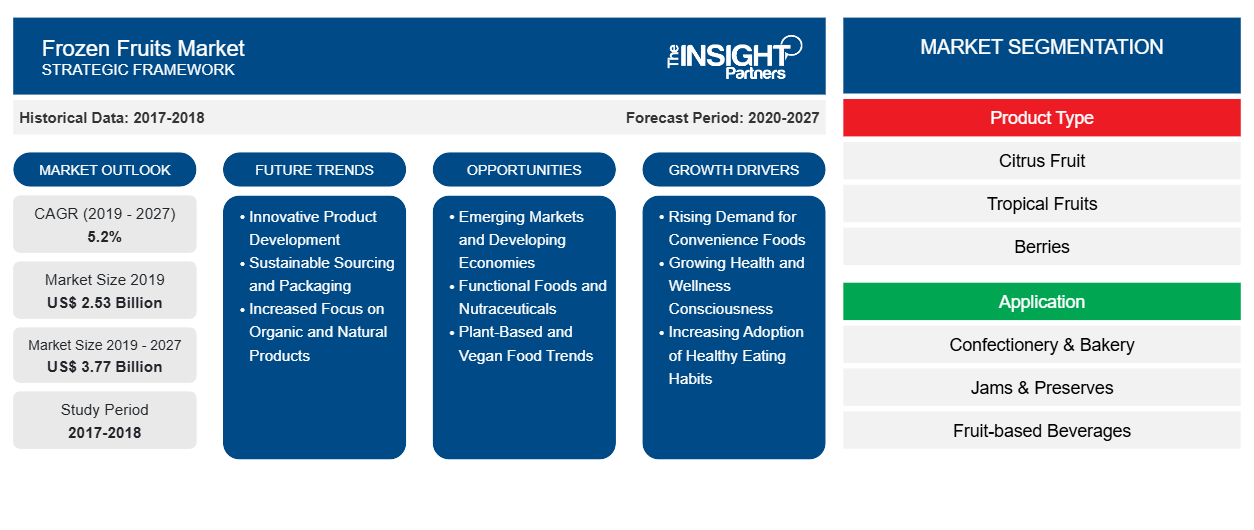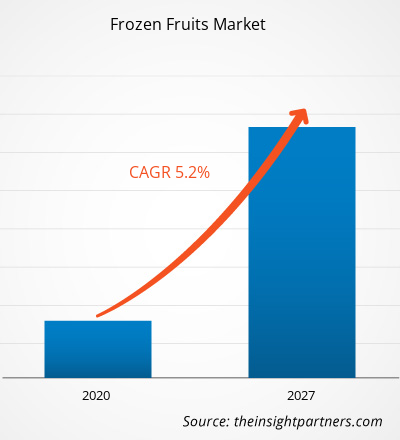[Forschungsbericht] Der Markt für Tiefkühlfrüchte wurde im Jahr 2019 auf 2.528,46 Millionen US-Dollar geschätzt und soll bis 2027 3.769,45 Millionen US-Dollar erreichen; im Prognosezeitraum wird mit einer durchschnittlichen jährlichen Wachstumsrate von 5,2 % gerechnet .
Früchte, die auf ihrem Höhepunkt der Reife gepflückt werden, werden schnell eingefroren und bei flüssiger Stickstofftemperatur verpackt. Das Verfahren sorgt für eine längere Haltbarkeit der frischen Früchte. Wie frische Früchte sind auch gefrorene Früchte mit verschiedenen Antioxidantien, Mineralien und Vitaminen angereichert. Die im Vergleich zu frischen Früchten leichtere Verfügbarkeit von gefrorenen Früchten, insbesondere der saisonalen, hat jedoch ihre weltweite Nachfrage angekurbelt.
Im Jahr 2019 hatte Europa den größten Anteil am globalen Markt für Tiefkühlobst, gefolgt von Nordamerika und dem asiatisch-pazifischen Raum. Deutschland und Frankreich dominieren den Markt für Tiefkühlobst in Europa. Neben der wachsenden Bevölkerung unterstützen steigende verfügbare Einkommen und ein aktiver Lebensstil, die die Nachfrage nach praktischen Snacks ankurbeln, das Wachstum des Marktes für Tiefkühlobst in Europa. Darüber hinaus hat der zunehmende Fokus der Hersteller von Tiefkühlobst auf die Einführung neuer Sorten von Tiefkühlobst, um eine größere Zahl von Verbrauchern anzulocken, das Marktwachstum in den europäischen Ländern weiter angekurbelt.
Der COVID-19-Ausbruch begann im Dezember 2019 in Wuhan (China) und hat sich seitdem weltweit rasant ausgebreitet. Im November 2020 waren die USA, Brasilien, Indien, Russland, Südafrika, Mexiko und Großbritannien einige der am schlimmsten betroffenen Länder in Bezug auf bestätigte Fälle und gemeldete Todesfälle. Der COVID-19-Ausbruch hat die Wirtschaft und Industrie in verschiedenen Ländern durch die Verhängung von Ausgangssperren , Reiseverboten und Geschäftsschließungen beeinträchtigt. Lebensmittel und Getränke sind eine der wichtigsten Branchen, die unter schwerwiegenden Störungen wie Unterbrechungen der Lieferkette, Absagen von Technologieveranstaltungen und Büroschließungen leiden. Die Schließung verschiedener Anlagen und Fabriken in Regionen wie Nordamerika, Europa und im asiatisch-pazifischen Raum beeinträchtigt die globalen Lieferketten und wirkt sich negativ auf die Herstellung, Lieferpläne und den Verkauf aus. Darüber hinaus beeinträchtigen die weltweiten Reiseverbote die Möglichkeiten für Geschäftskooperationen und Partnerschaften. Die Betriebsunterbrechung in der Lebensmittel- und Getränkeindustrie hat das Wachstum des Marktes für Tiefkühlfrüchte in verschiedenen Ländern zusätzlich eingeschränkt.
Passen Sie diesen Bericht Ihren Anforderungen an
Sie erhalten kostenlos individuelle Anpassungen an jedem Bericht, einschließlich Teilen dieses Berichts oder einer Analyse auf Länderebene, eines Excel-Datenpakets sowie tolle Angebote und Rabatte für Start-ups und Universitäten.
- Holen Sie sich die wichtigsten Markttrends aus diesem Bericht.Dieses KOSTENLOSE Beispiel umfasst eine Datenanalyse von Markttrends bis hin zu Schätzungen und Prognosen.
Markteinblicke
Steigende Nachfrage aus der verpackten und verarbeiteten Lebensmittelindustrie
Tiefkühlfrüchte sind mit Vitaminen, Proteinen, Kohlenhydraten, Antioxidantien und anderen Nährstoffen angereichert. Sie werden in verschiedenen Küchen verwendet, um Nährstoffe und Geschmack zu verleihen. Diese Früchte finden Anwendung in der Lebensmittelverarbeitungsindustrie und werden in Backwaren, Süßwaren und anderen verpackten Lebensmitteln verwendet. Sie werden zur Herstellung von Marmelade und anderen Fruchtaufstrichen, Fruchtgetränken und Milchprodukten verwendet. Aufgrund des hektischen und geschäftigen Lebensstils ist der Konsum dieser verzehrfertigen Lebensmittel und Getränke in den letzten Jahren deutlich gestiegen. Darüber hinaus ermutigen steigende verfügbare Einkommen und verbesserte wirtschaftliche Bedingungen die Verbraucher in Industrie- und Entwicklungsländern, Geld für verpackte Lebensmittel wie Snacks und Backwaren auszugeben, was die Nachfrage nach Tiefkühlfrüchten weiter ankurbelt. Darüber hinaus hat die Diversifizierung der Vertriebskanäle im Einzelhandel und in Supermärkten für Fertiggerichte gesorgt und so deren Umsätze gesteigert. Somit treibt die wachsende Nachfrage der verpackten und verarbeiteten Lebensmittelindustrie und der Direktverbraucher den Markt für Tiefkühlfrüchte an.
Einblicke in Produkttypen
Der Markt für Tiefkühlfrüchte ist nach Produkttyp in Zitrusfrüchte, tropische Früchte, Beeren und andere unterteilt. Im Jahr 2019 dominierte das Segment der tropischen Früchte den Markt für Tiefkühlfrüchte. Viele tiefgekühlte tropische Früchte wie Mango, Papaya, Apfel, Litschi, Banane, Drachenfrucht, Pflaume, Guave und Passionsfrucht liegen weltweit im Trend. Neben dem Einfrieren können die Hersteller diese Früchte auch durch Waschen, Schälen, Sortieren, Schneiden, Blanchieren, Deaktivieren der Enzymaktivität usw. verarbeiten, je nachdem, welche Form für das Endprodukt bevorzugt wird. Tiefgekühlte tropische Früchte werden in Fruchtcocktails, Smoothies, Eiscreme, Desserts, Konservierungsmitteln, Gebäck, Joghurt und Getränken verwendet. Einige tropische Früchte, die hauptsächlich bei der Verarbeitung ethnischer Lebensmittel verwendet werden, sind gefrorene Mangos (Chutney), gefrorene Avocado (Guacamole) und Guaven (Ponche Navideño). Die zunehmende Verwendung tropischer Früchte in verschiedenen Produkten wird den Markt dieses Segments voraussichtlich ankurbeln.
Anwendungseinblicke
Basierend auf der Anwendung ist der Markt für Tiefkühlobst in Süßwaren und Backwaren, Marmeladen und Konfitüren, Fruchtgetränke, Milchprodukte und andere unterteilt. Im Jahr 2019 dominierte das Süßwaren- und Backwarensegment den Markt für Tiefkühlobst. Tiefkühlobst wird zunehmend in Back- und Süßwarenprodukten sowie in Milchprodukten wie Joghurt und Eiscreme verwendet. Darüber hinaus ist die Nachfrage nach Tiefkühlobst aus dem Segment der Fruchtgetränke aufgrund der steigenden Vorliebe der Verbraucher für gesunde Getränke erheblich gestiegen. Die zunehmende Neigung zu Bio-Lebensmitteln stimuliert auch das Wachstum des Marktes für Tiefkühlobst.
Technik-Einblicke
Basierend auf der Technik ist der Markt für Tiefkühlobst in Gefriertrocknung und individuelles Schnellgefrieren (IQF) segmentiert. Das Segment Gefriertrocknung hatte 2019 einen größeren Marktanteil, und das Segment individuelles Schnellgefrieren wird voraussichtlich zwischen 2020 und 2027 die schnellste CAGR verzeichnen. Beim Gefriertrocknen wird das Obst eingefroren und dann in ein Vakuum gelegt. Durch den niedrigen Druck können Eiskristalle exponentiell wachsen und werden direkt von festem Eis in Wasserdampf verwandelt. Diese Methode entzieht dem Obst Wasser sogar noch schneller als der herkömmliche Trocknungsprozess. Tatsächlich wird der Wassergehalt des Obstes verringert, ohne seine Zusammensetzung zu beeinträchtigen. Diese Methode der Lebensmittelkonservierung eignet sich am besten für zuckerarme, weiche Früchte wie Himbeeren und Erdbeeren. Durch Gefriertrocknung bleiben Früchte lange haltbar und halten bei richtiger Konservierung viele Jahre.
Zu den wichtigsten Marktteilnehmern zählen Crop's Fruits NV, Dole Packaged Foods LLC., MireliteMirsa Co. Ltd., SunOpta Inc., Titan Frozen Fruits, Wawona Frozen Foods, Welch Foods, Inc., Greenyard, JR Simplot Company und General Mills Inc. Die Unternehmen verfolgen Strategien wie Fusionen und Übernahmen. Die großen Akteure streben danach, durch die Ausweitung ihrer weltweiten Präsenz einen größeren Kundenstamm zu gewinnen.
Regionale Einblicke in den Markt für gefrorene Früchte
Die regionalen Trends und Faktoren, die den Markt für Tiefkühlfrüchte im Prognosezeitraum beeinflussen, wurden von den Analysten von Insight Partners ausführlich erläutert. In diesem Abschnitt werden auch die Marktsegmente und die Geografie von Tiefkühlfrüchten in Nordamerika, Europa, im asiatisch-pazifischen Raum, im Nahen Osten und Afrika sowie in Süd- und Mittelamerika erörtert.

- Erhalten Sie regionale Daten zum Markt für Tiefkühlfrüchte
Umfang des Marktberichts über gefrorene Früchte
| Berichtsattribut | Details |
|---|---|
| Marktgröße im Jahr 2019 | 2,53 Milliarden US-Dollar |
| Marktgröße bis 2027 | 3,77 Milliarden US-Dollar |
| Globale CAGR (2019 - 2027) | 5,2 % |
| Historische Daten | 2017-2018 |
| Prognosezeitraum | 2020–2027 |
| Abgedeckte Segmente | Nach Produkttyp
|
| Abgedeckte Regionen und Länder | Nordamerika
|
| Marktführer und wichtige Unternehmensprofile |
|
Marktteilnehmerdichte: Der Einfluss auf die Geschäftsdynamik
Der Markt für Tiefkühlfrüchte wächst rasant, angetrieben durch die steigende Nachfrage der Endverbraucher aufgrund von Faktoren wie sich entwickelnden Verbraucherpräferenzen, technologischen Fortschritten und einem größeren Bewusstsein für die Vorteile des Produkts. Mit steigender Nachfrage erweitern Unternehmen ihr Angebot, entwickeln Innovationen, um die Bedürfnisse der Verbraucher zu erfüllen, und nutzen neue Trends, was das Marktwachstum weiter ankurbelt.
Die Marktteilnehmerdichte bezieht sich auf die Verteilung der Firmen oder Unternehmen, die in einem bestimmten Markt oder einer bestimmten Branche tätig sind. Sie gibt an, wie viele Wettbewerber (Marktteilnehmer) in einem bestimmten Marktraum im Verhältnis zu seiner Größe oder seinem gesamten Marktwert präsent sind.
Die wichtigsten auf dem Markt für Tiefkühlfrüchte tätigen Unternehmen sind:
- Grüner Hof
- Titan Gefrorene Früchte
- Dole Packaged Foods LLC.
- Sunopta Inc.
- JR Simplot Unternehmen
Haftungsausschluss : Die oben aufgeführten Unternehmen sind nicht in einer bestimmten Reihenfolge aufgeführt.

- Überblick über die wichtigsten Akteure auf dem Markt für gefrorene Früchte
Bericht-Spotlights
- Fortschrittliche Branchentrends auf dem globalen Markt für Tiefkühlfrüchte helfen den Akteuren bei der Entwicklung wirksamer langfristiger Strategien
- Von Unternehmen verfolgte Geschäftswachstumsstrategien, um in entwickelten und sich entwickelnden Märkten zu wachsen
- Quantitative Analyse des globalen Marktes für Tiefkühlfrüchte von 2017 bis 2027
- Schätzung der Nachfrage nach gefrorenen Früchten in verschiedenen Branchen
- PEST-Analyse zur Veranschaulichung der Wirksamkeit der in der Branche tätigen Käufer und Lieferanten bei der Vorhersage des Marktwachstums
- Aktuelle Entwicklungen zum Verständnis der Wettbewerbssituation auf dem Markt und der Nachfrage nach Tiefkühlobst
- Markttrends und -aussichten sowie Faktoren, die das Wachstum des Marktes für Tiefkühlfrüchte vorantreiben und bremsen
- Verständnis der Strategien, die das kommerzielle Interesse im Hinblick auf das Wachstum des globalen Marktes für Tiefkühlfrüchte untermauern, um den Entscheidungsprozess der Beteiligten zu erleichtern
- Marktgröße für gefrorene Früchte an verschiedenen Marktknoten
- Detaillierte Übersicht und Segmentierung des globalen Marktes für gefrorene Früchte sowie seiner Dynamik in der Branche
- Marktgröße für Tiefkühlfrüchte in verschiedenen Regionen mit vielversprechenden Wachstumschancen
Markt für gefrorene Früchte nach Produkttyp
- Zitrusfrucht
- Tropische Früchte
- Beeren
- Sonstiges
Markt für gefrorene Früchte, nach Anwendung
- Süßwaren & Bäckerei
- Marmeladen & Konfitüren
- Fruchtgetränke
- Molkerei
- Sonstiges
Markt für gefrorene Früchte, nach Technik
- Gefriertrocknung
- Individuelles Schnellgefrieren
Firmenprofile
- Crop's Fruits NV
- Dole Packaged Foods LLC.
- MireliteMirsa Co. Ltd.
- SunOpta Inc.
- Titan Gefrorene Früchte
- Wawona Tiefkühlkost
- Welch Foods Inc.
- Grüner Hof
- JR Simplot Unternehmen
- General Mills Inc
- Historische Analyse (2 Jahre), Basisjahr, Prognose (7 Jahre) mit CAGR
- PEST- und SWOT-Analyse
- Marktgröße Wert/Volumen – Global, Regional, Land
- Branche und Wettbewerbsumfeld
- Excel-Datensatz


- Single-Use Negative Pressure Wound Therapy Devices Market
- Medical and Research Grade Collagen Market
- Online Exam Proctoring Market
- Broth Market
- Electronic Shelf Label Market
- Point of Care Diagnostics Market
- Arterial Blood Gas Kits Market
- Travel Vaccines Market
- Bathroom Vanities Market
- Drain Cleaning Equipment Market

Report Coverage
Revenue forecast, Company Analysis, Industry landscape, Growth factors, and Trends

Segment Covered
This text is related
to segments covered.

Regional Scope
North America, Europe, Asia Pacific, Middle East & Africa, South & Central America

Country Scope
This text is related
to country scope.
Häufig gestellte Fragen
The growth of the berries segment is primarily attributed to the fact that berries include frozen raspberries, strawberries, blackberries, blueberries, chokeberries, cherries, black currant, mulberries, cranberries, gooseberries, red currants, and others. North America and Europe have experienced a high market for blackberries and raspberries. Warm weather across the globe has taken a toll on the steady production of berries, increasing the demand for frozen varieties. Frozen berries are among the healthiest foods that are tasty, nutritious, and have a range of fantastic health benefits. The frozen blueberries have many health benefits such as improved digestion, improved heart health, improved motor function, reduced risk of forms of dementia and Alzheimer's disease, and improved nervous system health. Health benefits associated with berries is expected to drive the growth of this segment. All these factors are responsible for the berries segment to grow at the highest rate.
The major players operating in the global frozen fruits market are Greenyard, Crop's Fruits NV, Mirelite Mirsa Co. Ltd., Wawona Frozen Foods, Welch Foods, Inc, J.R. Simplot Company, General Mills Inc, Dole Packaged Foods LLC, Sunopta Inc, and Titan Frozen Fruit among many others.
In 2018, the frozen fruits market was predominant in Asia-Pacific at the global level. Surge in demand of frozen fruits in various food processing industries such as bakery, confectionery & other packaged food items like bread, cakes, and pastry has had a noteworthy influence on the frozen fruits market in Asia- Pacific. The market for frozen fruits in Asia- Pacific is witnessing growth owing to the presence of well-established players such as SunOpta Inc., Greenyard, and Dole Packaged Foods LLC. and others in this region. With the rise in demand for the healthy and convenience food among the consumers in the region is expected to continue to grow over the projected period. The popularity of the frozen fruits has increased within the region, particularly in Australia, China, India, Japan, South Korea, and Rest of APAC. Its use in food and beverages industry has had a noteworthy influence on the frozen fruits market in Asia- Pacific. Owing to busy & hectic lifestyles, there is a noticeable increase in the consumption of these ready-to-eat food products and beverages over the past few years which will further support product demand. Also, the swift in the middle- class population, along with growth in urbanization and rise in disposable income available in the hands of people, leads to the rise in demand for both frozen fruits & convenience food is also anticipated to fuel the market size over the forecast period. The market for frozen fruits is picking up pace in this region, owing to the development of new manufacturing industries together with the government support to increase the industrial production in food and beverages sector.
Trends and growth analysis reports related to Food and Beverages : READ MORE..
The List of Companies - Global Frozen Fruits Market
- Greenyard
- Titan Frozen Fruit
- Dole Packaged Foods LLC.
- Sunopta Inc.
- J.R. Simplot Company
- General Mills Inc.
- Welch Foods, Inc.
- Wawona Frozen Foods
- Mirelite Mirsa Co. Ltd.
- Crop's Fruits NV
The Insight Partners performs research in 4 major stages: Data Collection & Secondary Research, Primary Research, Data Analysis and Data Triangulation & Final Review.
- Data Collection and Secondary Research:
As a market research and consulting firm operating from a decade, we have published and advised several client across the globe. First step for any study will start with an assessment of currently available data and insights from existing reports. Further, historical and current market information is collected from Investor Presentations, Annual Reports, SEC Filings, etc., and other information related to company’s performance and market positioning are gathered from Paid Databases (Factiva, Hoovers, and Reuters) and various other publications available in public domain.
Several associations trade associates, technical forums, institutes, societies and organization are accessed to gain technical as well as market related insights through their publications such as research papers, blogs and press releases related to the studies are referred to get cues about the market. Further, white papers, journals, magazines, and other news articles published in last 3 years are scrutinized and analyzed to understand the current market trends.
- Primary Research:
The primarily interview analysis comprise of data obtained from industry participants interview and answers to survey questions gathered by in-house primary team.
For primary research, interviews are conducted with industry experts/CEOs/Marketing Managers/VPs/Subject Matter Experts from both demand and supply side to get a 360-degree view of the market. The primary team conducts several interviews based on the complexity of the markets to understand the various market trends and dynamics which makes research more credible and precise.
A typical research interview fulfils the following functions:
- Provides first-hand information on the market size, market trends, growth trends, competitive landscape, and outlook
- Validates and strengthens in-house secondary research findings
- Develops the analysis team’s expertise and market understanding
Primary research involves email interactions and telephone interviews for each market, category, segment, and sub-segment across geographies. The participants who typically take part in such a process include, but are not limited to:
- Industry participants: VPs, business development managers, market intelligence managers and national sales managers
- Outside experts: Valuation experts, research analysts and key opinion leaders specializing in the electronics and semiconductor industry.
Below is the breakup of our primary respondents by company, designation, and region:

Once we receive the confirmation from primary research sources or primary respondents, we finalize the base year market estimation and forecast the data as per the macroeconomic and microeconomic factors assessed during data collection.
- Data Analysis:
Once data is validated through both secondary as well as primary respondents, we finalize the market estimations by hypothesis formulation and factor analysis at regional and country level.
- Macro-Economic Factor Analysis:
We analyse macroeconomic indicators such the gross domestic product (GDP), increase in the demand for goods and services across industries, technological advancement, regional economic growth, governmental policies, the influence of COVID-19, PEST analysis, and other aspects. This analysis aids in setting benchmarks for various nations/regions and approximating market splits. Additionally, the general trend of the aforementioned components aid in determining the market's development possibilities.
- Country Level Data:
Various factors that are especially aligned to the country are taken into account to determine the market size for a certain area and country, including the presence of vendors, such as headquarters and offices, the country's GDP, demand patterns, and industry growth. To comprehend the market dynamics for the nation, a number of growth variables, inhibitors, application areas, and current market trends are researched. The aforementioned elements aid in determining the country's overall market's growth potential.
- Company Profile:
The “Table of Contents” is formulated by listing and analyzing more than 25 - 30 companies operating in the market ecosystem across geographies. However, we profile only 10 companies as a standard practice in our syndicate reports. These 10 companies comprise leading, emerging, and regional players. Nonetheless, our analysis is not restricted to the 10 listed companies, we also analyze other companies present in the market to develop a holistic view and understand the prevailing trends. The “Company Profiles” section in the report covers key facts, business description, products & services, financial information, SWOT analysis, and key developments. The financial information presented is extracted from the annual reports and official documents of the publicly listed companies. Upon collecting the information for the sections of respective companies, we verify them via various primary sources and then compile the data in respective company profiles. The company level information helps us in deriving the base number as well as in forecasting the market size.
- Developing Base Number:
Aggregation of sales statistics (2020-2022) and macro-economic factor, and other secondary and primary research insights are utilized to arrive at base number and related market shares for 2022. The data gaps are identified in this step and relevant market data is analyzed, collected from paid primary interviews or databases. On finalizing the base year market size, forecasts are developed on the basis of macro-economic, industry and market growth factors and company level analysis.
- Data Triangulation and Final Review:
The market findings and base year market size calculations are validated from supply as well as demand side. Demand side validations are based on macro-economic factor analysis and benchmarks for respective regions and countries. In case of supply side validations, revenues of major companies are estimated (in case not available) based on industry benchmark, approximate number of employees, product portfolio, and primary interviews revenues are gathered. Further revenue from target product/service segment is assessed to avoid overshooting of market statistics. In case of heavy deviations between supply and demand side values, all thes steps are repeated to achieve synchronization.
We follow an iterative model, wherein we share our research findings with Subject Matter Experts (SME’s) and Key Opinion Leaders (KOLs) until consensus view of the market is not formulated – this model negates any drastic deviation in the opinions of experts. Only validated and universally acceptable research findings are quoted in our reports.
We have important check points that we use to validate our research findings – which we call – data triangulation, where we validate the information, we generate from secondary sources with primary interviews and then we re-validate with our internal data bases and Subject matter experts. This comprehensive model enables us to deliver high quality, reliable data in shortest possible time.


 Holen Sie sich ein kostenloses Muster für diesen Bericht
Holen Sie sich ein kostenloses Muster für diesen Bericht